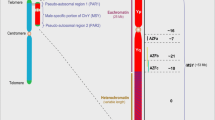Summary
The origin and behavior of human dicentric chromosomes are reviewed. Most dicentrics between two non-homologous or two homologous chromosomes (isodicentrics), which are permanent members of a chromosome complement, probably originate from segregation of an adjacent quadriradial; such configurations are the result of a chromatid translocation between two nonhomologous chromosomes, or they represent an adjacent counterpart of a mitotic chiasma. The segregation of such a quadriradial may also give rise to a cell line monosomic for the chromosome concerned (e.g., a 45,X line). Contrary to the generally held opinion, isodicentrics rarely result from an isolocal break in two chromatids followed by rejoining of sister chromatids. In this case the daughter centromeres go to opposite poles in the next anaphase, and the resulting bridge breaks at a random point. This mechanism, therefore, leads to the formation of an isodicentric chromosome only if the two centromeres are close together, or if one centromere is immediately inactivated. Observations on the origin of dicentrics in Bloom syndrome support these conclusions. One centromere is permanently inactivated in most dicentric chromosomes, and even when the dicentric breaks into two chromosomes, the centromere is not reactivated. The appearance and behavior of the “acentric” X chromosomes show that their centromeres are similarly inactivated and not prematurely divided. Two Bloom syndrome lymphocytes, one with an extra chromosome 2 and the other with an extra chromosome 7, each having an inactivated centromere, show that this can also happen in monocentric autosomes.
Similar content being viewed by others
References
Daniel A (1979) Single Cd band in dicentric translocation with one suppressed centromere. Hum Genet 48:85–92
Daniel A, Lyons N, Casey JH, Gras L (1980) Two dicentric isochromosomes, one without the Yqh heterochromatic segment. Hum Genet 54:31–39
de la Chapelle A, Stenstrand K (1974) Dicentric human X chromosomes. Hereditas 76:259–268
Dewald GW (1983) Isodicentric X chromosomes in humans: origin, segregation behavior, and replication band patterns. In: Sandberg AA (ed) Cytogenetics of the mammalian X chromsome, part A. Liss, New York, pp 405–426
Dewald GW, Boros SJ, Conroy MM, Dahl RJ, Spurbeck JL, Vitek HA (1979) A tdic(5;15)(p13;p11) chromosome showing variation for constriction in the centromeric regions in a patient with the cri du chat syndrome. Cytogenet Cell Genet 24:15–26
Distèche C, Hagemeijer A, Frederic J, Progneaux D (1972) An abnormal large human chromosome identified as an end-to-end fusion of two Xs by combined results of the new banding techniques and microdensitometry. Clin Genet 3:388–395
Drets ME, Therman E (1983) Human telomeric 6;19 translocation chromosome with a tendency to break at the fusion point. Chromosoma 88:139–144
Fitzgerald PH, Morris CM (1984) Telomeric association of chromosomes in B-cell lymphoid leukemia. Hum Genet 67:385–390
Fitzgerald PH, Pickering AF, Mercer JM, Miethke PM (1975) Premature centromere division: a mechanism of non-disjunction causing X chromosome aneuploidy in somatic cells of man. Ann Hum Genet 38:417–428
Kuhn EM, Therman E (1979) Chromosome breakage and rejoining of sister chromatids in Bloom's syndrome. Chromosoma 73:275–286
Laurent C, Biemont M-C, Philip T, Dutruge J, Bellon G, Bethenod M, Gilly R, Ladreyt JF (1978) Translocations termino-terminales de novo entre deux chromosomes 18. A propos de deux observations 46,XY,ter rea(18;18)(pter;pter). Ann Genet (Paris) 21:78–82
Levan G (1970) Contributions to the chromosomal characterization of the PTK1 rat-kangaroo cell line. Hereditas 64:85–96
Maraschio P, Zuffardi O, Lo Curto F (1980) Cd bands and centromeric function in dicentric chromsomes. Hum Genet 54:265–267
Mascarello JT, Jones MC, Hoyme HE, Freebury MM (1983) Duplication (17p) in a child with an isodicentric (17p) chromosome. Am J Med Genet 14:67–72
Nakagome Y, Abe T, Misawa S, Takeshita T, Iinuma K (1984) The “loss” of centromeres from chromosomes of aged women. Am J Hum Genet 36:398–404
Niebuhr E (1972) A 45,XX,5-,13-,dic+ karyotype in a case of cridu-chat syndrome. Cytogenetics 11:165–177
Pallister PD, Patau K, Inhorn SL, Opitz JM (1974) A woman with multiple congenital anomalies, mental retardation and mosaicism for an unusual translocation chromsome t(6;19). Clin Genet 5:188–195
Rivera H, Solé MT, García-Cruz D, Martínez-Wilson M, Cantú JM (1984) On telomere replication and fusion in eukaryotes: a propos of a case of 45,X/46,X,ter rea(X;X)(p22.3;p22.3). Cytogenet Cell Genet 38:23–28
Sarto GE, Therman E (1980) Replication and inactivation of a dicentric X formed by telomeric fusion. Am J Obstet Gynecol 136:904–911
Schwartz S, Palmer CG, Weaver DD, Priest J (1983) Dicentric chromosome 13 and centromere inactivation. Hum Genet 63:332–337
Sekhon GS, Hillman LS, Kaufman RL (1975) Identification of a 19/20 translocation by G-, Q- and C-banding. Birth Defects 11:237–240
Sit KH, Wong HB (1981) Translocation dicentric chromosomes in prostaglandin E2 induced abortuses and possible aneusomy through asynchronous centromeric divisions. Cytogenet Cell Genet 29:60–64
Therman E (1985) Human chromosomes, structure, behavior, effects, 2nd edn. Springer, New York Heidelberg Berlin
Therman E, Kuhn EM (1981) Mitotic crossing-over and segregation in man. Hum Genet 59:93–100
Therman E, Kuhn EM (1985) Incidence and origin of symmetric and asymmetric dicentrics in Bloom's syndrome. Cancer Genet Cytogenet 15:293–301
Therman E, Patau K (1974) Abnormal X chromsomes in man: origin, behavior and effects. Humangenetik 25:1–16
Therman E, Sarto GE, Patau K (1974) Apparently isodicentric but functionally monocentric X chromosome in man. Am J Hum Genet 26:83–92
Tomkins DJ (1978) Cytogenetic findings in Roberts-SC phocomedia syndrome. Am J Hum Genet 30:95A
Ward BE, Bradley CM, Cooper JB, Robinson A (1981) Homodicentric chromosomes: a distinctive type of dicentric chromosome. J Med Genet 18:54–58
Wisniewski L, Politis GD, Higgins JV (1978) Partial tetrasomy 9 in a liveborn infant. Clin Genet 14:147–153
Zakharov AF, Baranovskaya LI (1983) X-X chromosome translocations and their karyotype-phenotype correlations. In: Sandberg AA (ed) Cytogenetics of the mammalian X chromosome, part B. Liss, New York, pp 261–279
Zuffardi O, Tiepolo L (1981) Latent centromere and chromosome function in man. Clin Genet 19:547
Author information
Authors and Affiliations
Rights and permissions
About this article
Cite this article
Therman, E., Trunca, C., Kuhn, E.M. et al. Dicentric chromosomes and the inactivation of the centromere. Hum Genet 72, 191–195 (1986). https://doi.org/10.1007/BF00291876
Received:
Issue Date:
DOI: https://doi.org/10.1007/BF00291876




